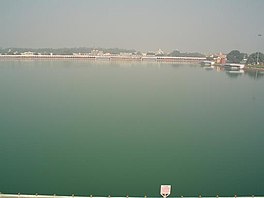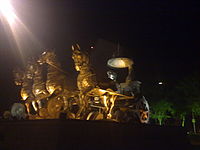
Haryana is an Indian state located in the northern part of the country. It was carved out after the linguistic reorganisation of Punjab on 1 November 1966. It is ranked 21st in terms of area, with less than 1.4% of India's land area. The state capital is Chandigarh, which it shares with the neighbouring state of Punjab; and the most populous city is Faridabad, which is a part of the National Capital Region. The city of Gurgaon is among India's largest financial and technology hubs. Haryana has 6 administrative divisions, 22 districts, 72 sub-divisions, 93 revenue tehsils, 50 sub-tehsils, 140 community development blocks, 154 cities and towns, 7,356 villages, and 6,222 villages panchayats.

Bhrigu was a rishi in Hinduism. He was one of the seven great sages, the Saptarshis, and one of the many Prajapatis created by Brahma. The first compiler of predictive astrology and also the author of Bhrigu Samhita, an astrological (jyotisha) classic. Bhrigu is considered a manasaputra ("mind-born-son") of Brahma. The adjectival form of the name, Bhargava, is used to refer to the descendants and the school of Bhrigu. According to Manusmriti, Bhrigu was a compatriot of and lived during the time of Manu, the progenitor of humanity. Along with Manu, Bhrigu had made important contributions to the Manusmriti, which was constituted out of a sermon to a congregation of saints in the state of Brahmavarta, after the great floods in this area. As per the Skanda Purana, Bhrigu migrated to Bhrigukaccha, modern Bharuch, on the banks of the Narmada river in Gujarat, leaving his son Chyavana at Dhosi Hill.
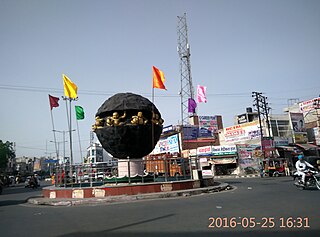
Kaithal is a city and municipal council in the Kaithal district of the Indian state of Haryana. Kaithal was previously a part of Karnal district and later, Kurukshetra district until 1 November 1989, when it became the headquarters of the Kaithal. It shares a border with the Patiala district of state Punjab and the Kurukshetra, Jind and Karnal districts of Haryana. Kaithal district is situated in the North-West of the Haryana state. Its North-West boundaries, which include Guhla-Cheeka are attached to Punjab.

Kurukshetra is a city and administrative headquarters of Kurukshetra district in the Indian state of Haryana. It is also known as Dharmakshetra and as the "Land of the Bhagavad Gita".

Pushkar Lake or Pushkar Sarovar is located in the town of Pushkar near Ajmer city in Ajmer district of the Rajasthan state of western India. Pushkar Lake is a sacred lake of the Hindus. The Hindu scriptures describe it as "Tirtha-Guru" [Thirtha Raj]– the perceptor of pilgrimage sites related to a water-body and relate it to the mythology of the creator-god Brahma, whose most prominent temple stands in Pushkar. The Pushkar Lake finds mention on coins as early as the 4th century BC.

Kurukshetra district is one of the 22 districts of Haryana state in northern India. The town of Kurukshetra, a sacred place for the Hindus, is the administrative headquarters of this district. The district occupies an area of 1530.00 km2. The district has a population of 964,655. This district is part of Ambala division. Kurukshetra is also the land of Srimad Bhagawad Gita. Jyotisar is the place in Kurukshetra where Krishna is believed to deliver the sermon of Gita to Arjuna in the Mahabharata.

Gita Mahotsav,Gita Jayanti, also known as Mokshada Ekadashi or Matsya Dvadashi is a Hindu observance that marks the day the Bhagavad Gita dialogue occurred between Arjuna and Krishna on the battlefield of Kurukshetra. It is celebrated on Shukla Ekadashi, the 11th day of the waxing moon of the lunar month Margashirsha (December–January) of the Hindu calendar.
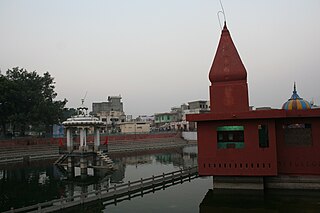
Pehowa is a town and a municipal committee in Kurukshetra district in the Indian state of Haryana. It is an important sacred Hindu pilgrimage site, related to Krishna and Mahabharata, within the 48 Kos Parikrama of Kurukshetra. The Hindu genealogy registers at Peohwa, Haryana are kept here at the Pruthudak Tirath on the banks of Sarasvati river.

Sannihit Sarovar is a sacred water reservoir in the Kurukshetra district of Haryana, India. It is believed to be the meeting point of seven sacred Sarasvatis. The sarovar, according to popular belief, contains sacred water. Bathing in the sacred waters of the tank on the day of Amavasya, or on the day of an eclipse is believed to bestow blessings equivalent to performing the ashvamedh yajna.

Jyotisar, on the bank of Jyotisar Sarovar wetland, is a Hindu pilgrimage site in the city of Kurukshetra in Haryana state of India. According to Hindu tradition, Krishna delivered the sermon of Bhagavad Gita - the doctrine of Karma and Dharma to his wavering friend Arjuna to guide him to resolve his ethical dilemma and revealed his vishvarupa to him.
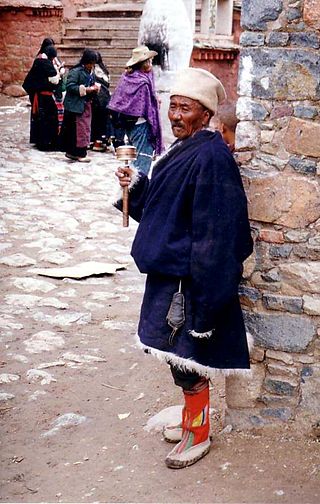
The most important places in Buddhism are located in the Indo-Gangetic Plain of southern Nepal and northern India. This is the area where Gautama Buddha was born, lived, and taught, and the main sites connected to his life are now important places of pilgrimage for both Buddhists and Hindus. Many countries that are or were predominantly Buddhist have shrines and places which can be visited as a pilgrimage.

Brahma Temple, Pushkar is a Hindu temple situated at Pushkar in the Indian state of Rajasthan, close to the sacred Pushkar Lake to which its legend has an indelible link.

In Hinduism, the yatra (pilgrimage) to the tirthas has special significance for earning the punya needed to attain the moksha (salvation) by performing the darśana, the parikrama (circumambulation), the yajna, the Dhyana, the puja (worship), the prarthana, the dakshina, the seva, the bhandara, etc. These sacred places are usually located on the banks of sacred waters, such as sacred rivers or their tributaries, the kundas, the ghats, or the stepwells, or the temple tanks.

Dhosi Hill is an important Vedic period site, an extinct volcano, standing alone at the north-west end of the Aravalli mountain range. Its height varies from about 345 to 470 meters from the surrounding lands and 740 meters from the sea level. At present the hill has temples, a pakka pond, ruins of a fort, caves and forest around it. In the ancient times, as per various scriptures like Mahabharata - Vanparv, Puranas, Shathpath Brahmana etc. the hill had Ashrams of various Rishis who made contributions to Vedic scriptures.

Yatra, in Indian-origin religions, Hinduism, Buddhism, Jainism and Sikhism, generally means a pilgrimage to holy places such as confluences of sacred rivers, sacred mountains, places associated with Hindu epics such as the Mahabharata and Ramayana, and other sacred pilgrimage sites. Visiting a sacred place is believed by the pilgrim to purify the self and bring one closer to the divine. The journey itself is as important as the destination, and the hardships of travel serve as an act of devotion in themselves.
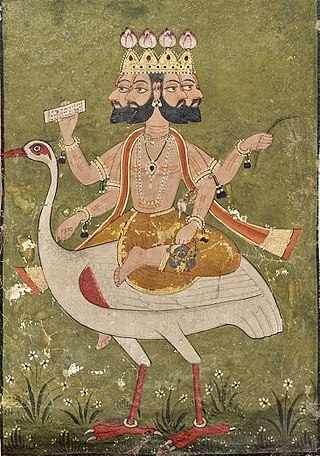
Brahma is a Hindu god, referred to as "the Creator" within the Trimurti, the trinity of supreme divinity that includes Vishnu and Shiva. He is associated with creation, knowledge, and the Vedas. Brahma is prominently mentioned in creation legends. In some Puranas, he created himself in a golden embryo known as the Hiranyagarbha.

Kurukshetra University, Kurukshetra (KUK) is a university established on 11 January 1956 in Kurukshetra, in the Indian state of Haryana, 160 kilometres (99 mi) from the capital, Delhi. It is a member of Association of Commonwealth Universities.
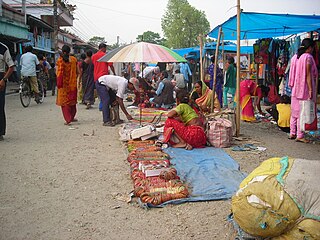
Haat Bazaar (হাটবাজার) is an open-air market that serves as a trading venue for local people in rural areas and towns mainly in Bangladesh, Bhutan, Nepal and India. Haat bazaars are conducted on a regular basis, usually once, twice or thrice a week, and in some places once every fortnight. At times, haat bazaars are organized in a different manner, to support or promote trading by and with rural people. In addition to providing trading opportunities, haat bazaars serve as meeting places, rural settlements come up around the haats which gradually grow into towns.

The 48 kos parikrama is a parikrama of various Mahabharata-related and other Vedic-era tirthas around the holy city of Kurukshetra in the state of Haryana, India.

Nabha House is a palatial building which was used by the royal family of Nabha as residence for the days religious performances were being done at Kurukshetra. It was adopted by Archaeological Survey of India in 2005 and they worked 9 years, spending close to INR 1.5 crore to bring it back to its original form.
